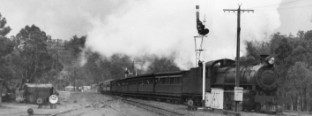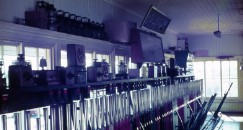Geraldton
GERALDTON | |
WAGR - Northern Railway (N. R.) | |
1938 WAGR MAP Mileage = 306 | |
Location Map | |
Next Down Station: | Next Up Station: |
BLUFF POINT | |
Quick Facts |
|
Opened |
Closed |
1915 |
1922 |
Mechanical |
Electrical |
70 Levers |
? |
Fate: Completely Removed |
|
One of the oddities of WAGR Safeworking was the relative scarcity of signal boxes at the country ports served by the WAGR. Of the eight such ports (including the two isolated railway ports of Hopetoun and Port Hedland) only two; Albany and Geraldton were graced with such cabins. Albany’s box was not installed until 1960 (a mere 71 years after the opening of the Great Southern Railway from Beverley) and survived just long enough to see that lines centenary. Perhaps befitting its status as the terminus of the WAGRs first railway line, Geraldton’s box was installed much earlier, and closed much sooner.
Geraldton’s signal cabin was opened sometime in or about May 1915. Prior to this the Geraldton signalling arrangements had been rudimentary, limited to a ground frame working Up Home and Up Distant Signals and a Down Stating Signal. The precise date of the opening has eluded the author as the WAGR Weekly Notices for 1915 are silent on the subject. The only contemporaneous record located to date is an article in the Geraldton Guardian of 27 April 1915 in which the reporter described the then soon to be completed station, signalling and yard facilities at Geraldton, built to replace the hopelessly inadequate and cramped facilities that had opened with the line. Below is an extract from the article:
THE NEW RAILWAY STATION.
NEW AND COMMODIOUS PREMISES
-
A TOUR OF INSPECTION
-
"... The signal box, though one of the smallest buildings in the yard, is one of the most important. It is constructed so that through the windows every portion of the yard can be seen by the men on duty, who have no fewer than 70 levers to look after and manipulate..."
Source: Geraldton Guardian newspaper, Page 2, Tuesday, 27th April, 1915.
The absence of any reference in the Weekly Notices is puzzling; perhaps wartime censorship considerations deemed that this information was too sensitive to national security to be promulgated, although thus begs the question as to how the the Guardian slipped underneath the official radar. Perhaps the authorities considered it unlikely that any self-respecting German or Turkish spy would waste his time reading a regional newspaper!
The signal box at Geraldton was a reasonably sized facility. It housed 70 levers and was located at the northwest end of the platforms, controlling the entrance to the platform roads and the yard. Whether the box was a standard WAGR timber and galvanised iron structure or built of more substantial materials is unknown: The surviving information gives no clue and to date no definitive photograph of the box has been located, although a photo of what probably is Geraldton signal box is believed to be in the possession of a Rail Heritage WA member. The signal box controlled what was possibly the greatest collection of bracketed signal posts in a country WAGR location outside of Kalgoorlie, with all starters and home signals being placed on such posts. There was even a bracketed signal post displaying distant signals for trains approaching Geraldton on the main line from Narngulu and the branch from Wokarina. Trains could depart from Geraldton from 5 different roads towards either Narngulu, travelling on electric staff, or Wokarina, travelling on a Staff or Ticket, the starting signals for both routes being located on an impressive array of bracketed posts. Leaving Geraldton, the lines to Wokarina and Narngulu ran adjacent to each for approximately 3 kilometres, providing the potential for parallel running although racing was strictly prohibited. Similar parallel layouts of main and branch were to be found at York, Narrogin, Coolgardie and Merredin, although Geraldton’s was by far the longest.
Unfortunately, Geraldton’s signal box was to have but a short life. The 1920s were to be period of both consolidation and decline for the WAGR. Prior to the First World War the WA State Government had instituted a program of building a network of country branch lines to facilitate agriculture and pastoralism. These lines were built as cheaply as possible. Throughout the 1920s the Government continued this program, saddling the WAGR with lines that were both expensive to operate and hopelessly unremunerative. Not surprisingly, the Railways operating losses steadily increased. Rather than investing in improvements that might reduce the WAGRs operating costs, in February 1922 the Government established a Royal Commission to inquire into and report on ways to make the running and administration of the WAGR more economic and efficient. The Commission investigated, deliberated and pontificated in a remarkably short time, handing down its recommendations in July of the same year. Mr Stead, the Royal Commissioner, took a dim view of the signalling arrangements at Geraldton, considering them to be over elaborate and unnecessary. He recommended the closure of the box and rationalisation of the signals, saving the WAGR some 400 pounds per year in Signalman’s wages and maintenance costs. This recommendation was accepted with alacrity, and in late September 1922 Geraldton box was closed and the interlocking removed. Fixed signals were reduced to a starter from the main line and dock road to Narngulu and Wokarina, and a Home and a Distant signal for trains approaching from either location, all controlled from a simple ground frame at the Narngulu end of the platform.
This arrangement was to last until the closure of Geraldton yard in 1989 (when the facilities transferred to Narngulu), the only significant alteration prior to this being the elimination of the signals relevant to Wokarina when that line closed in 1957. Despite the surge in traffic during World War Two, the post-war increase in wheat traffic and the opening of Geraldton as an iron ore port handle ore trans from Koolanooka, traffic at Geraldton never increased to a level such as to justify re-introduction of a signal box. Perhaps even in the 1960s the WAGR let itself be ruled from the 1922 Commission’s grave.
Today there is no evidence that a signal box ever existed at Geraldton. The yard and most traces of the formation leading into the station have disappeared under more profitable development. Geraldton continues to be used as a port, albeit approached from a totally new alignment. As a result of major increases in iron ore traffic automatic signalling from Mullewa to Geraldton will soon be introduced, although this will be controlled from Midland, an economy that perhaps even the good Royal Commissioner would have approved.
NOTE: This page is under development - please check back later, however, if you have any additional information on this signal cabin, it would be most welcome - please use the e-mail form provided.
Any additional information on this signal cabin would be most welcome - please use the e-mail form provided on this page.
Information researched and interpreted by Justin Smith of the Signalling Interest Group of W. A.
Additional Information supplied by Chris. J. E. French of SignallingWA
Photo by Justin Smith courtesy of Rail Heritage WA Archives
This page is copyright, and permission must be sought from SignallingWA before this page is used for any purpose other than personal education.
[Buy this page] or [View your SignallingWA ShoppingCart]
GERALDTON Employees | ||
This list may not be complete and does not yet include employees who worked here without being appointed. Where an appointment date is unknown, the Weekly Notice (WN) date advising of the appointment or other official documentation, i.e. Certificate of Competency (CC) will be used. | ||
Name | Appointed | Position |
Is a name missing? Please submit any corrections / additions with suitable evidence using the e-mail form above. | ||


